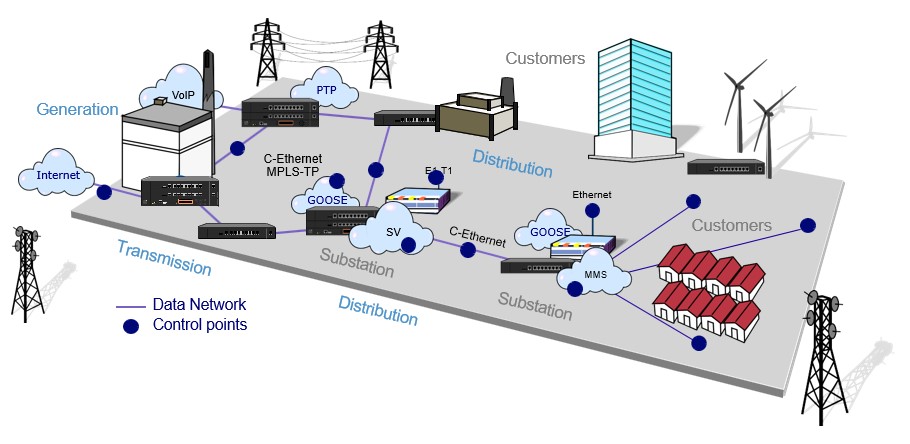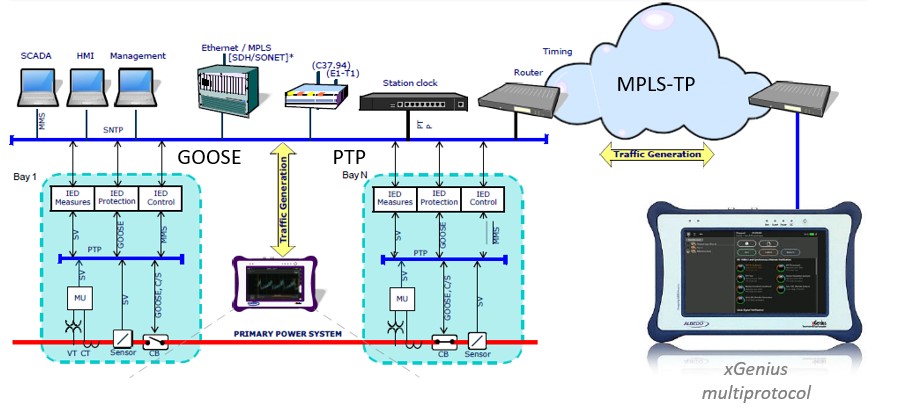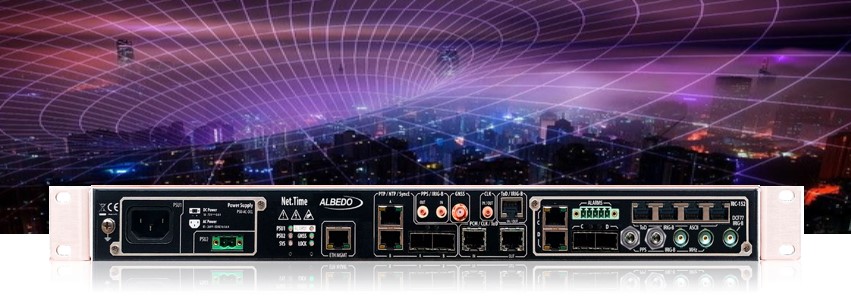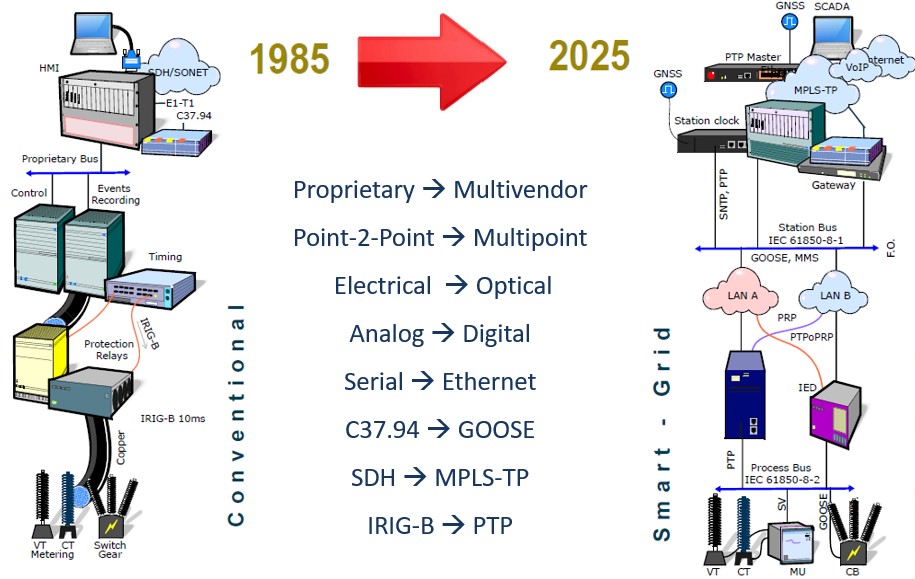IEC-61850 Challenges
The transition to IEC 61850 has become a strategic priority for utility and infrastructure providers. Despite its promise of interoperability it presents deployment challenges—from protocol complexity and timing precision to cybersecurity
RIO de JANEIRO, APRIL 10, 2025
Challenges deploying IEC 61850
The transition to IEC 61850 has become a strategic priority for utility and infrastructure providers. Despite its promise of interoperability and efficiency, the standard presents real-world deployment challenges—from protocol complexity and timing precision to cybersecurity. This white paper explores how ALBEDO tools and methodology support engineering teams through planning, testing, and successful deployment.

1. Introduction: The Smart Grid Transformation
The evolution of power systems into smart grids is driven by the need for efficiency, flexibility, and security. Telecom technologies are foundational to this transformation, as they provide the infrastructure to interconnect distributed resources, control systems, and monitoring devices. IEC 61850 emerges as a key enabler of this digital transformation, standardizing communication among Intelligent Electronic Devices (IEDs).
The adoption of IEC 61850 entails a paradigm shift:
- From proprietary to multivendor systems
- From point-to-point to multipoint architectures
- From electrical to optical media
- From analog to digital signal processing
- From serial to Ethernet communications
- From IRIG-B to PTP for timing
After over 20 years of development and refinement, IEC 61850 is now entering a phase of wide-scale deployment.
2. The Complexity of IEC 61850
IEC 61850 integrates multiple protocols including GOOSE, MMS, SV, and relies heavily on precise time synchronization via PTP and NTP. While powerful, this stack introduces complexity unfamiliar to many engineers rooted in classical electrical disciplines.
Challenges
- Engineers may lack training in Ethernet, control protocols, and timing systems
- Difficulties in interpreting failure modes due to protocol layering
- Increased commissioning times from misconfiguration or network design flaws
ALBEDO’s Answer
- xGenius and Zeus testers offer a learning platform that allows engineers to visualize, simulate, and analyze real-time traffic across these protocols
- Tools to identify and troubleshoot configuration errors early in the deployment process
3. Engineering and Data Modeling Hurdles
SCL (Substation Configuration Language) is at the heart of IEC 61850 engineering. It facilitates powerful modeling of IEDs, substations, and communication flows. However, managing and understanding these configurations can be daunting.
Challenges
- Handling hybrid configurations with both legacy and IEC 61850 elements
- Validating configurations generated by vendor-specific tools
ALBEDO’s Answer
- Encourage the use of independent testing tools to validate configurations
- Provide simulators and analyzers that help understand SCL descriptions and verify their behavior in test environments
4. Conformance vs. Acceptance Testing
IEC 61850 is a standard, but that doesn’t guarantee interoperability across vendor devices. Each implementation may include proprietary extensions or interpretations.

Conformance Testing
- Verifies protocol compliance (e.g. PTP, GOOSE, SV)
- Ensures devices meet specification
Acceptance Testing
- Evaluates behavior under real network conditions
- Assesses performance under load, during failover, and across topologies
ALBEDO’s Answer
- Net.Storm simulates WAN conditions, packet loss, latency, jitter, and failover scenarios
- xGenius measures delays and verifies message sequencing across protocols and interfaces

5. Teleprotection: Where Timing Is Critical
Teleprotection applications, often based on C37.94 or GOOSE, require extremely fast and deterministic communication. Faults must be detected and isolated in milliseconds.
Challenges
- Asymmetric delays, jitter, or misconfigurations may lead to false trips or failure to trip
ALBEDO’s Answer
- Zeus tester simulates protection events and evaluates performance under fault conditions
- Verifies delays, jitter, and trigger mechanisms in a controlled lab or field setup

6. Synchronization: Precision and Resilience
Timing is the backbone of modern substations. SV and GOOSE rely on PTP, NTP, or IRIG-B for temporal coherence. Poor synchronization causes cascading failures.
Challenges
- Hybrid environments mixing legacy and new systems
- Loss of sync leading to data misinterpretation

ALBEDO’s Answer
- Net.Time is a modular multi-protocol clock that integrates legacy and new standards
- Supports PRP, holdover via OCXO/Rubidium, and spoofing detection
- xGenius diagnoses synchronization health and measures network timing performance
7. Cybersecurity: Balancing Safety
Cybersecurity was not a core concern when IEC 61850 was first defined. Securing the network is now essential, but introduces performance tradeoffs.
Challenges
- Secured profiles (IEC 62351) may introduce latency and affect determinism
- GNSS spoofing or jamming can disable synchronization
ALBEDO’s Answer
- Net.Time offers multi-GNSS support, spoofing detection, authentication, and signal holdover
- xGenius and Net.Storm simulate attack scenarios to test network resilience
8. Migration or Integration?

Utilities face decisions about whether to replace legacy systems or integrate them. IEC 61850 allows for layering on top of existing systems, but the path depends on specific technical and economic factors.
Migration Paths
- SDH to MPLS-TP
- Serial to Ethernet
- GOOSE to replace hardwired signals (or coexist)
- IRIG-B and C37.94 coexisting with PTP and GOOSE
ALBEDO’s Answer
- Devices that support legacy and IEC 61850 protocols reduce migration friction
- Tools designed for hybrid networks simplify testing and validation during transition

9. ALBEDO Ecosystem
ALBEDO provides a comprehensive suite of tools tailored for IEC 61850 environments:
- xGenius / Zeus: Multi-protocol testers for validation, troubleshooting, and training
- Net.Storm: WAN simulator to test acceptance conditions
- Net.Time: Multi-protocol clock for accurate, secure, and resilient timing
With more than 800 customers in five continents, ALBEDO’s solutions have been proven in power utilities, transportation, data centers, and defense sectors.
Conclusion
IEC 61850 is a transformative standard with the potential to modernize energy systems. Its complexity requires rigorous preparation, training, and testing. ALBEDO delivers an integrated ecosystem to support each phase of deployment, from design and simulation to validation and commissioning. Our mission is to reduce deployment time, improve system resilience, and ensure interoperability across the smart grid.



